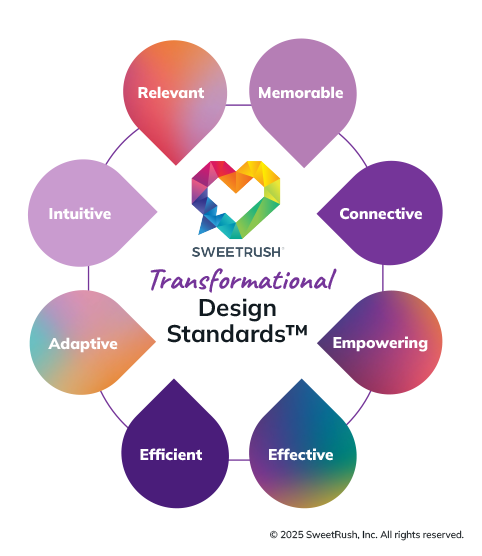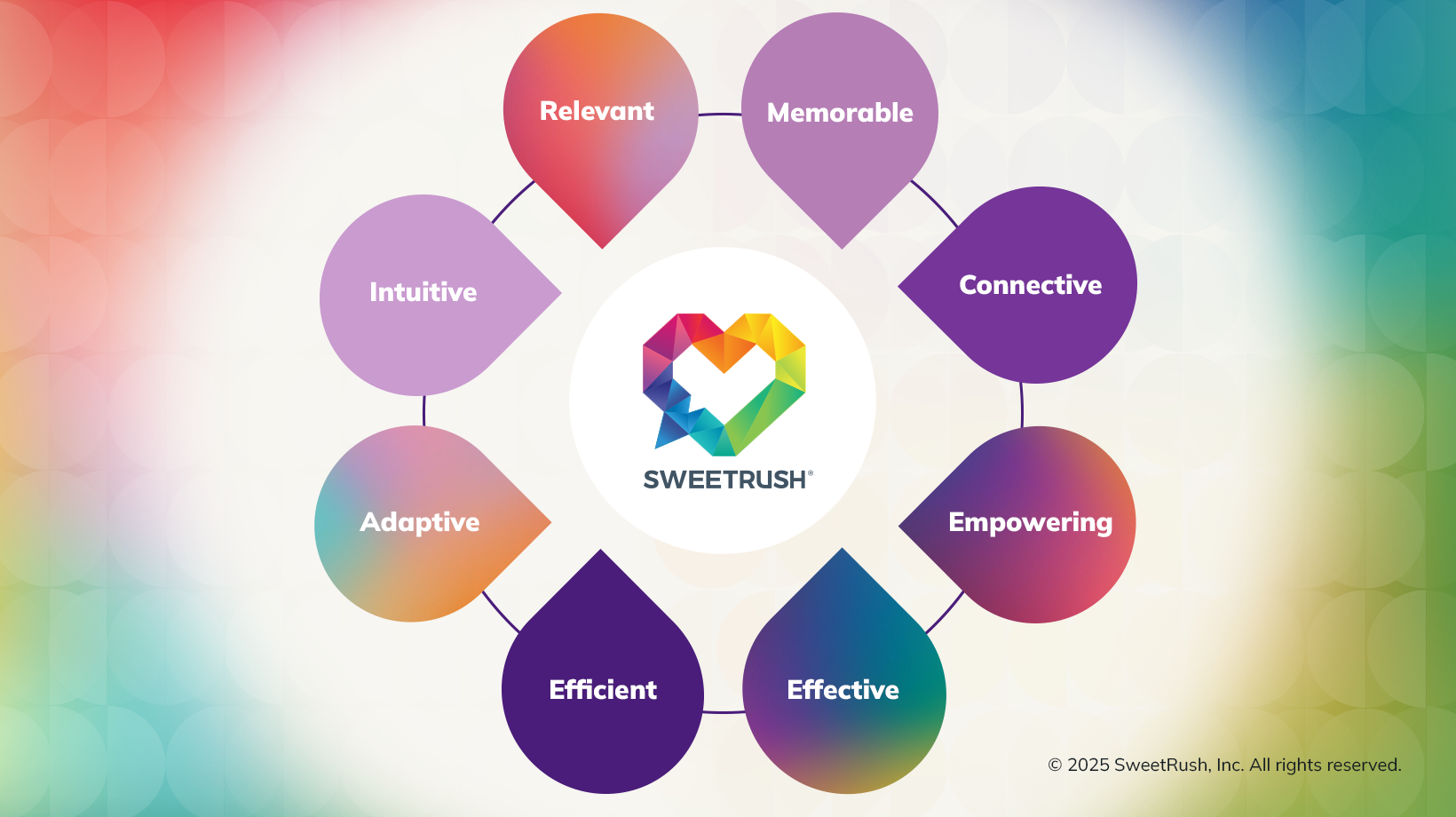SweetRush’s Transformational Design Standards™ (TDS) provide a framework L&D teams can apply to craft learning experiences (LXs) that demonstrably work and are delivered on time and within budget.
The Standards build on the premise that people learn only when they want to learn, and that people want to learn when they see the value of learning—both to them, and to their organization. Good LX makes people want to learn by offering a means to solve their problems and improve their talents.
And good LX translates to real business impact, too. When people take the time to learn, pay more attention to the training, and gain the conviction to perform better on the job, your business moves forward.
SweetRush developed the TDS to provide a language for discussing good learning design. It helps clients and SweetRush quickly derive the most fruitful approach and keeps us both focused on business outcomes as we bring the design to fruition.
The Standards are divided into two distinct groups:
- Four of the Standards apply only to the LX itself: qualities that maximize learning and help bring about desired outcomes. They are irrelevant after the LX is over.
- Four of the Standards apply only to the outcome of an LX, identifying the ways the LX will make learners better and achieve business results, measurable mainly after the LX is over.

LX-Based Transformational Design Standards™ (During LX)
When crafting an LX, we need to put ourselves in the learner’s shoes and think about what training we would want. The more we can improve the LX, within time and budget, the better the business result.
The following standards can be used to refine and improve the LX itself:
-
Relevant
The LX immediately applies to a learner’s needs and interests. A good LX makes clear its connection to a learner’s job or concerns.
One way to heighten relevance is to couch the training within the context of a situation or story so learners see its applicability in action. Another is to use terms and concepts that are familiar to the learner so they can map the training to their world. Examples of how the subject applies to familiar situations are always useful.
-
Intuitive
The LX makes sense to learners. A good LX should be easy to navigate, which minimizes cognitive load and allows the learner to focus on the subject.
A good way to make training more intuitive is to use logical and consistent navigation. Providing a visual flow using colors, organization, and content placement can also help lessen cognitive load. Also, representing concepts visually can make them more approachable.
-
Adaptive
The LX accommodates learner differences. After all, we each have differing skills, understandings, interests, experiences, and capacities.
There are a variety of techniques to personalize training for different learners: Creating variants of the curricula for different populations of learners, offering optional “tell me more” detours within the training, and allowing learners to “test out” of content they already know all make training more individualized.
-
Efficient
The LX respects the learner’s time. We each have less and less time to devote to learning and betterment, so effective LX optimizes every minute.
As we develop training, it is important to look for ways to make it easier to fit into a learner’s busy day.
Does an included video really need to be 10 minutes long, or can we trim it to five (or omit it altogether)? Can we chunk the training into short segments so it can be more easily consumed over time? Can we tighten large blocks of text into more succinct chunks? Can we use visual representations rather than lengthy text descriptions?
Outcome-Based Transformational Design Standards™ (After LX)
Training is only a means to an end. Its ultimate worth lies in how the learner has changed once the LX is over. In other words, it’s about the learner’s ability to perform or behave better upon returning to the job. The following standards focus on what happens after the LX has been consumed.
-
Memorable
Learners can recall skills and knowledge when needed. Once the learners are back at work, they need to remember what they learned in order to apply it.
There are a variety of techniques available to ensure that learners can better remember what they’ve learned once they’re back at their jobs. For example, consider giving them a job aid, offering them a mnemonic, framing the training as a thought-provoking story (which is more easily remembered), and/or offering a means to do a quick lookup of training content while performing a task. Providing an overlay on top of a digital platform that offers just-in-time/just-enough guidance is also useful.
-
Connective
Learners are more joined to the system (human or otherwise) in which they operate. To amplify its impact, the LX should leverage connections between a learner and the people, processes, and technologies in their lives.
One way to make the training more connective is to group learners into cohorts so they can rely on each other to master the skills and knowledge. Another way is to assign a coach they can turn to for advice and encouragement. For training related to a system, such as helping learners master a software platform, giving them a sandbox on the platform to safely experiment within is invaluable.
-
Empowering
Learners gained the capacity to act and have the confidence to do so. After the LX is done, learners need both the ability and the confidence to apply their learning on the job.
We need to make sure learners have the tools and authority to do things differently once they’re back on the job. We also need to ensure that learners feel confident that they can perform better, which we can achieve by providing feedback that acknowledges their mastery within the training: for example, by commending them when they do well and offering practical advice for improving when they don’t.
-
Effective
Learners gained proficiency and now understand more. The LX should improve learners’ proficiency to bring about the desired organizational outcomes.
This is the true litmus test of an LX’s quality. An LX designer should have a deep understanding of what “success” looks like and should work from the start to identify how it will be measured—for example, via KPIs. Providing capstone activities or simulations within the training that mimic the work learners do on the job and measuring learners’ performance within them is a means of measuring training effectiveness.
We believe that if L&D teams focus on these eight TDS standards as they craft an LX, they are more likely to create one that delivers business results.
Wondering what the Transformational Design Standards™ (TDS) look like in practice? Check out this whirlwind video tour of 11 real-life client projects that leveraged these standards and successfully drove organizational change.





